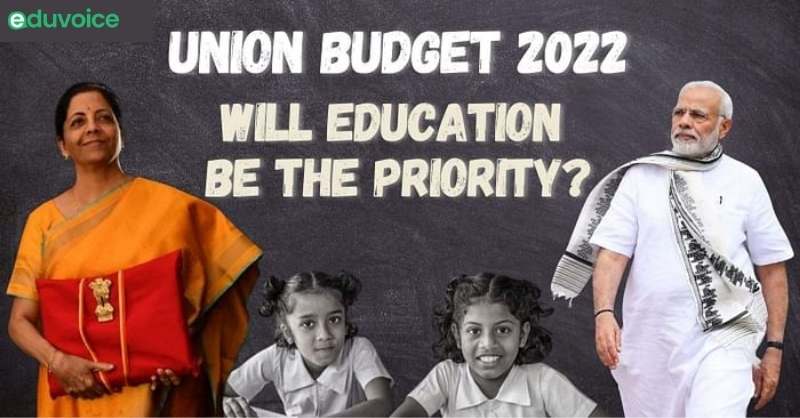India needs to spend more on education. This is not a debate. It’s a fact. But will the Narendra Modi government increase allocation towards education in the upcoming Union Budget 2022? That’s the question on everyone’s mind.
Education expenditure as a percentage of GDP was at an abysmal 2.8 percent during 2014-2019 and increased to 3-3.5 percent in the 2019-21 period, reported the Economic Survey 2020-21. The sector was allotted only Rs 93,224 crore for 2021, with Rs 54,873 crore for school education and literacy and Rs 38,350 crore for the higher education sector. The government rationalized this 6 percent cut in allocation with the pandemic and its ensuing effects.
There are two questions that immediately spring to mind:
Will the allocations increase this time?
Can the pandemic really be an excuse for lower spending on education?
If we suppose that the government will increase education expenditure, the next question is which sector within education should get it. School and college education have the majority votes here. But why is spending on primary, secondary, and even the first level of tertiary or higher education so important? Because it helps build an invaluable resource — human capital. A skilled and educated labor force takes you faster on the path to development with a higher growth rate. The new age demands a highly skilled labor force and educating them is the only way towards growth, feel experts.
Demand for education
Research and studies said that India is on a revival path. But the country wasn’t at what one would call a great place even before the pandemic hit. Over the past few years, even pre-pandemic, India’s growth rate has been sub-par — lower than the long-term average.
The strategy that the government followed after that included initiatives like Make in India and Aatmanirbhar Bharat, which are manufacturing-focused and have their mindset on infrastructural development like highways etc. This is a very standard approach. But manufacturing today has evolved. It’s not as labor intensive as it used to be. The low-cost manufacturing China capitalized on is not possible now,” said Dr. Partha Chatterjee, Professor, and Head of the Department of Economics at Shiv Nadar University.
Dr. Partha Chatterjee
But launching schemes and programmes does not cut it, it needs to be implemented as well. Technology has evolved and has become an integral part of manufacturing as well. This has changed the demand for labour. We need more skilled labour now who can operate these sophisticated new-age setups. “Now, you need skilled labour and India is lagging in that front. So we need investment in skilling the labour force. There are two parts to this — a short-term solution where we target the younger population who can learn and re-learn to advance in their career and a solution for long term sustainable growth. But to skill the labour force, they need fundamental education that is lacking,” Dr. Chatterjee added.
This brings us to another age-old criticism. Our education system is too focused on examinations and marks, said Prateek Shukla, Co-founder and CEO of Masai School. “We are really not looking at skilling. All over the world, we see governments moving to outcome-based learning as the future of education. Over the last two years, school dropouts have increased. More and more Indian kids are not completing their school education. In the budget, we should see some interventions to keep students in school to at least complete their high school education,” he added.
Primary Focus is what we need, right?
Primary education needs a boost — this seems to be the consensus. And we need that boost right now before it’s too late. We boast of being a young country. But we might not stay young for too long. This is the time, experts say that we should increase investment in primary education. Otherwise, it might be too late.
We have another three decades till the average age of our population starts going up. We need to go back to school education and see what needs to be done and how we can give people the basic education that puts them in a position to be skilled. Now, we are in a position where we do not have enough people who can be trained. For long-term sustainable growth, we need to go back to school education and this cannot be done quickly. Enrolment rates had gone up but this (pandemic) shock is huge and can spell a disaster. Especially, the lower classes have been affected the most and that affects the foundations of education,
Explains Dr Chatterjee.
Dr Ramanand Nand, the Director, and founding member of a think tank named Center of Policy Research & Governance (CPRG) agreed that it is high time that we start investing more in education. “We have missed too many trains when it comes to education. We missed it back in the 60s when countries like China, Japan and South Korea were investing a lot in education. Some countries started spending more on education in the 2000s. Now, we are living in a period when technology has become a driving force and it can push us towards development. It is a very natural expectation from the government that they invest more in the education sector,” Dr. Nand said.
But the focus can be even refined. Eminent academician Dr. Amit Bhaduri said that government should build toilets for girl children in primary schools on priority. Sounds odd? Why not recruit teachers? Dr. Bhaduri’s proposition is long-term. It has positive externalities. While improving their health and sanitary conditions is the immediate and direct effect, it will bring them to school and the indirect effects include, more educated girls, reduced population growth rate and much more. “One of the first things that the government should do in the primary education sector is building toilets for girl students. I think, in India, this is the first priority. If it is a functioning school then this is the priority when it comes to capital expenditure. This has lots of externalities,” he added.
Centre of Excellence. Earn it
A budget is always a competition between what you invest more in, which sector gets more — because there are constraints. “The government does not have resources,” said economist Dr Sugata Marjit. “After the pandemic, every country in the world is suffering due to scarcity of revenue resources. This government is suffering too and no amount of daydreaming can compensate for that. So I believe that the government should judiciously spend on primary, secondary and the first leg of the tertiary education which are the colleges,” said Dr Marjit, the First Distinguished Professor at the Indian Institute of Foreign Trade and the former VC of the University of Kolkata.
India, over the past few years, has gained IIMs, IITs and numerous centres of excellence across the country. But does that alone help boost the research ecosystem or development? “There’s no use of setting up very “hi-fi” research labs without any attention to primary, secondary and college education. But that is the attitude of our science and technology policy. We want to create excellence. There is no use in creating pockets of excellence in this country. A centre of excellence can’t just be created, it has to be achieved. There needs to be more focus on the quality of teachers and the teaching system,” said Dr Marjit.
But the buck does not stop there. We need to have investments in teachers’ training as well. “This is the bottom of the pyramid. That has to be strong. But it has continuously been ignored,” said Dr Basuthkar Jagadeeshwar Rao, Vice-Chancellor of the University of Hyderabad.
Teachers vs tabs: Whose power is it anyway?
Online education can, at best, supplement, but never be a substitute for physical classes, said Dr Chatterjee. “The sad thing that has happened is that we haven’t even tried hard to get kids back to school — we still don’t have vaccines for people younger than 15 years. We need to think about getting more teachers. We obviously need to think of ways to get students back to school. Studies have shown that giving out tabs or smartphones does not help the learning outcome. To get students back to school maintaining SOPs we need to have more teachers so that the students can be taught in shifts. Investments should be made to make schools safer for the students,” he added.
Internet connectivity or the lack of it has been the biggest divider for the past two years. While classes went online, it created a huge gap between the upper and lower strata of society. While urban kids had great to decent access to the internet, rural and remote India suffered — India still has approximately 37 per cent internet penetration. “I think this attempt to digitise rural primary education was an utter failure and it should not have been done. But if you want to move to an online set-up, the first thing is internet access at home. But how many of them have that?” asked economist Dr Amit Bhaduri.
What can the government do to bridge this glaring connectivity gap? Aakash Chaudhry, Managing Director, Aakash Educational Services Limited (AESL) said that the government should announce an attractive stimulus package and provisions for the education industry to bridge the gap between urban and rural areas. “The government also needs to support telecom companies so that they develop better infrastructure, internet connectivity, access to modern devices, ensuring last-mile delivery, quality guidance to the underserved who have been left behind owing to the digital divide,” added Chaudhry.
How much is enough?
Experts have, time and again, said that educational expenditure should be 6 per cent of the GDP. The golden number. But how much can India afford right now? Dr Marjit said that a 1 per cent rise from where we stand right now would be a great step up. But be careful to look out for the percentage of GDP allocated to education and not just the absolute value. “I am not very hopeful about an increase in allocation for education as a percentage of GDP. That’s what we need to look at. An increase in the absolute value of it is nothing but whitewash and all the allocations nowadays that the government emphasises are mostly the absolute value and that does not matter. We need to look at what percentage of GDP is being allocated. India’s current allocation for education is abysmally low compared to other countries,” said Dr Marjit.
But how much are others spending? “In most countries, basic education is nowadays perceived not only as a right but a duty. Governments around the world are nowadays widely perceived to be responsible for ensuring the provision of accessible quality education. As incomes – measured by GDP per capita – are increasing around the world, so are the global resources spent on education in absolute terms,” said Prashant Jain, CEO, Oswaal Books.
But it’s not the developed countries alone who are spending big bucks on education. “While developed countries go for a six-plus percentage allocation, there are many developing and even poorer countries which have a greater allocation of education expenditure as a percentage of GDP. The country that put everybody to shame is Cuba with an allocation of close to 12 per cent. And they have been doing that for a long time. If you look at some of these countries in Africa which are in a similar position, also have close to 6 per cent allocation. So the developing country excuse does not work here,” said Dr Marjit, the former Director of Centre for Studies in Social Sciences Calcutta (CSSSC).
Invest, Invest. That’s the mantra
Dr Marjit also pointed out that investment in India is abysmally low. The money being spent is not being used to create something new. “Quantity is a foolish target because you can say that the government is spending lakhs of crores yet India’s public investment rate is 7 per cent of the GDP. It has been stagnant for the past 20 years according to the World Bank data. Private investment has only grown 3 per cent in the late two decades. Any allocation in education is an investment in some sense — be it recruiting good quality teachers or building good labs for the students. India is now essentially withdrawing from every sphere of investment, and only spending money by borrowing, renting or leasing — it’s a fool’s paradise we are living in,” he said.
The outlook needs to change, said Marjit. “Expenditure does not mean anything at all unless you increase the rate of investment. And I don’t blame this government alone. I think the orientation should change and a 1 per cent increase in education expenditure as a share of GDP would be the first step towards a bigger change,” hoped the professor.
Who’s to Blame?
The past two years have seen the government talk about education more than it has done in years. The National Education Policy became a major talking point. But it’s been almost two years since. Not much has changed. “Even though the government has shown intent on these lines with the NEP 2020 and even certain allocations in the last budget, the pace is very slow. Coming to the investment part of it. No amount of investment is too much at this point. We are already lagging. And education affects an entire generation whenever there’s repeated low investment,” Dr Nand said.
But the onus is not only on the government, said Dr Marjit and added that the private sector must be compelled to invest in India. “I would say the corporates and the private sector are a worse culprit than the government. They do not invest. So what’s the way out? There is a simple solution. The government identify the first 100 corporate houses with a stock of assets or wealth beyond a certain level then say that they will give them a marginal tax of profits of 100 per cent if they don’t show that they are investing more than 2 per cent of the total corporate value-added for the next five years then those taxes will be exempted,” he added.
But the private sector says they are ready to invest and the government should help them. There is a huge education-employability gap that the private sector can help fill but they would need subsidies. “IMD’s World Competitiveness ranking places India’s education sector at a dismal 59th place out of 64 countries, with only 45 per cent of all graduates being considered employable. Obviously, we cannot expect India’s government to bridge this education-employability gap by itself. It needs greater support from the private sector along with wider deployment of technology to ensure its goal of quality education for all is met,” said Dr Akhil Shahani, Managing Director, Thadomal Shahani Centre for Management. “The union budget can facilitate this by reducing the GST rate for providing educational technology and ancillary services from 18 percent to at least 5 percent. In addition, it should allow private investors to set up schools and colleges with the ability to generate profits and equity returns. It should also allow foreign educational institutions to easily set up campuses in India, to promote healthy competition with local players. Collateral requirements for school and college educational loans should be reduced, along with interest rates, by public sector banks, to allow more families to afford the fees of quality institutions,” added Dr Shahani.
Politics of education
The political tiff between state governments and the central government has always come in the way of strengthening the primary and secondary educational infrastructure, said University of Hyderabad VC Dr BJ Rao. “The central and the state governments are not on the same page on many issues related to education. Most of the states where opposition parties are in power are not really gung-ho about NEP 2020. Unless the entire country is united in this, it will never have the intended effect,” said Dr Rao, who feels that education should be a central subject. “The entire power does not need to be in Delhi. It can be decentralised but there should be some level of uniformity,” he said.
Dr Rao pointed out that there are anomalies at the university level as well which is affecting education — state universities, he said, are in worse conditions. He has a unique proposition to solve this issue. Another ECI — Education Commission of India. “Why can’t we have an autonomous body that will take care of selection, recruitments, and appointments. Education should be bereft of any politics. Equal funding should come from states and the center. Much like the Election Commission of India’s autonomous functions, I would think an Education Commission of India would be feasible as well,” said the UoH VC.
But if you take away education from politics, why would there be political will? And political will is important in a set-up like India where even though people are invested in their kids’ education, they do not vote on those issues. “There might be demands across the country to open schools and colleges but there is no political will because it does not affect the political outcome. If you look at the Uttar Pradesh election, the schools have been closed for the past two years but it features nowhere. If you look at individual expenditure, a lot of it, across strata, goes into education. People are willing to spend money and send their kids to private schools. So, there is that aspiration. Yet it never features on the elections,” said Dr P Chatterjee from SNU.
Union Budget 2022: A lot riding on it
Yes, a lot is riding on the Union Budget 2022 and how much it allocates for education. The pandemic is not over and the health sector is the priority, but what’s next? Will education be the priority? Be it industry experts or economists or social scientists, everyone thinks it is high time the allocations are increased substantially and school and college education be made the focus. Education is such a sector where investment has multiple effects. The workforce will grow and become more skilled, social evils will wane as more people get basic education, women will be safer — the list can go on. Even though 6 percent of GDP being allocated to education might be a bit much to expect, isn’t a 4.5 per cent allocation reasonable? February 1 will answer all these questions.
For More Such Articles, News Update, Events, and Many More Click Here






